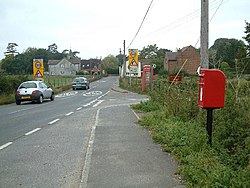Horton, Dorset: Difference between revisions
No edit summary |
m minor |
||
| Line 16: | Line 16: | ||
'''Horton''' is a village in eastern [[Dorset]], on the boundary between the chalk downland of [[Cranborne Chase]] and the [[Dorset Heaths]], ten miles north of [[Poole]]. The village had a recorded population of 515 at the 2001 census. | '''Horton''' is a village in eastern [[Dorset]], on the boundary between the chalk downland of [[Cranborne Chase]] and the [[Dorset Heaths]], ten miles north of [[Poole]]. The village had a recorded population of 515 at the 2001 census. | ||
The name ''Horton'' is a common one. It derives from the Old English ''horu tūn'' meaning "dirt/mud farm/estate', presumably indicating the soil. The earliest reference to Horton in Dorset is in a charter of 946 (albeit surviving only in a fourteenth-century copy), which mentions 'oþ hore tuninge gemære' ('to the boundary of the people of Horton').<ref>Victor Watts (ed.), ''The Cambridge Dictionary of English Place-Names, Based on the Collections of the English Place-Name Society'' (Cambridge: Cambridge University Press, 2004), s.v. ''HORTON''.</ref> | The name ''Horton'' is a common one. It derives from the Old English ''horu tūn'' meaning "dirt/mud farm/estate', presumably indicating the soil. The earliest reference to Horton in Dorset is in a charter of 946 AD (albeit surviving only in a fourteenth-century copy), which mentions 'oþ hore tuninge gemære' ('to the boundary of the people of Horton').<ref>Victor Watts (ed.), ''The Cambridge Dictionary of English Place-Names, Based on the Collections of the English Place-Name Society'' (Cambridge: Cambridge University Press, 2004), s.v. ''HORTON''.</ref> | ||
==About the village== | ==About the village== | ||
Latest revision as of 22:34, 11 July 2020
| Horton | |
| Dorset | |
|---|---|
 Horton | |
| Location | |
| Grid reference: | SU031075 |
| Location: | 50°52’1"N, 1°57’25"W |
| Data | |
| Post town: | Wimborne |
| Postcode: | BH21 |
| Dialling code: | 01258 |
| Local Government | |
| Council: | Dorset |
| Parliamentary constituency: |
North Dorset |
Horton is a village in eastern Dorset, on the boundary between the chalk downland of Cranborne Chase and the Dorset Heaths, ten miles north of Poole. The village had a recorded population of 515 at the 2001 census.
The name Horton is a common one. It derives from the Old English horu tūn meaning "dirt/mud farm/estate', presumably indicating the soil. The earliest reference to Horton in Dorset is in a charter of 946 AD (albeit surviving only in a fourteenth-century copy), which mentions 'oþ hore tuninge gemære' ('to the boundary of the people of Horton').[1]
About the village
The village has two unusual buildings: the Horton Tower, a five-storey Gothic red-brick observatory designed by Humphrey Sturt, the principal purpose of which now, is that of a disguised mobile phone mast for operator Vodafone, and the 18th-century Georgian church of St Wolfrida, built on the site of the tenth-century Horton Priory. Wolfrida (Wulfthryth) was the mother of Saint Edith of Wilton.[2]

Horton is claimed as the location, where James Scott, 1st Duke of Monmouth, was captured after the failed Monmouth Rebellion. Monmouth hid in a ditch under an ash tree disguised as a shepherd but was betrayed by a local woman who, according to legend, later killed herself in remorse.
The village once had a manor house but this was superseded by Crichel House, a nearby stately home, and the manor house decayed and was pulled down. The stables, now converted into the rectory, and a large ornamental lake, remain.
The nearby hamlet of Wigbeth was home of the botanist Emile Campbell-Browne (1830–1925) from about 1870 until his death, cited as due to decrepitude, in 1925. He is however buried in the graveyard of All Hallows (now in the parish of Wimborne St Giles) due to a dispute with the then vicar Thomas Case over the proposed moving of the pulpit.[3]
Outside links
| ("Wikimedia Commons" has material about Horton, Dorset) |
References
- ↑ Victor Watts (ed.), The Cambridge Dictionary of English Place-Names, Based on the Collections of the English Place-Name Society (Cambridge: Cambridge University Press, 2004), s.v. HORTON.
- ↑ Victoria County History: The Priory of Horton
- ↑ "Proceedings of the Dorset Natural History and: Dorset Natural History proceedings of the Dorset Natural History and Antiquarian Field Club. v.10. 1928". https://www.abebooks.co.uk/servlet/SearchResults?bi=0&bsi=480&bx=off&ds=30&kn=dorset%20history&recentlyadded=all&sortby=18&prevpage=15.
- Pitt-Rivers, Michael: 'Dorset' (Faber & Faber, 1968)
